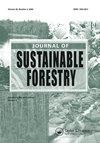Composition, structure and ecological importance of Moraceae in a residual forest of Ucayali, Peru
IF 1.8
4区 农林科学
Q3 FORESTRY
引用次数: 0
Abstract
Species of the Moraceae family are of great economic, medicinal and ecological importance in Amazonia. However, there are few studies on their diversity and population dynamics in residual forests. The objective was to determine the composition, structure and ecological importance of Moraceae in a residual forest. The applied method was descriptive and consisted of establishing 16 plots of 20 m × 50 m (0.10 ha), in a residual forest of the Alexánder von Humboldt substation of the National Institute of Agrarian Innovation-INIA, Pucallpa, department of Ucayali, where individuals of arboreal or hemi-epiphytic habit, with DBH ≥ 2.50 cm, were evaluated. The floristic composition was represented by 33 species, distributed in 12 genera; five species not recorded for Ucayali were found. Structurally, the family was represented by 138 individuals/ha with a horizontal distribution similar to an irregular inverted “J”. However, there were different horizontal structures among species. It was determined that 85% of the species were in diameter class I (2.50 to 9.99 cm), being the most abundant Pseudolmedia laevis (Ruiz & Pav.) J.F. Macbr. (41.88 individuals/ha); and the most dominant were Brosimum utile (Kunth) Oken (1.71 m2∕ha) and Brosimum alicastrum subsp. bolivarense (Pittier) C.C.Berg (0.90 m2/ha). Likewise, P. laevis and B. utile were the most ecologically important. The information from the present research will allow the establishment of a baseline, which can be used to propose the management of Moraceae in residual forests in the same study area.秘鲁乌卡亚利残林桑科植物的组成、结构及其生态意义
桑科植物在亚马逊地区具有重要的经济、药用和生态价值。然而,对其多样性和种群动态的研究很少。目的是确定桑科植物在残余林中的组成、结构和生态重要性。采用描述性方法,在乌卡亚利省普卡尔帕国立农业创新研究所(inia) Alexánder von Humboldt分站的残林中建立16个20 m × 50 m (0.10 ha)的样地,对胸径≥2.50 cm的乔木或半附生习性个体进行评价。区系组成有33种,分布于12属;在乌卡亚利发现了5个没有记录的物种。在结构上,该家族以138个/ha为代表,呈不规则倒“J”型水平分布。然而,不同物种间存在不同的水平结构。经测定,85%的种直径为I级(2.50 ~ 9.99 cm),是最丰富的假媒介laevis (Ruiz & Pav.)。参考书籍Macbr。(41.88人/公顷);其中,最主要的是溴铵(Kunth) Oken (1.71 m2∕ha)和溴铵(Brosimum alicastrum subsp)。bolivarense (Pittier) c.c.b berg (0.90 m2/ha)。同样地,绿叶假单胞菌和白叶假单胞菌的生态重要性最大。本研究的资料将允许建立一个基线,该基线可用于在同一研究区域的残林中提出Moraceae的管理建议。
本文章由计算机程序翻译,如有差异,请以英文原文为准。
求助全文
约1分钟内获得全文
求助全文
来源期刊

Journal of Sustainable Forestry
Social Sciences-Geography, Planning and Development
CiteScore
3.90
自引率
12.50%
发文量
42
期刊介绍:
Journal of Sustainable Forestry publishes peer-reviewed, original research on forest science. While the emphasis is on sustainable use of forest products and services, the journal covers a wide range of topics from the underlying biology and ecology of forests to the social, economic and policy aspects of forestry. Short communications and review papers that provide a clear theoretical, conceptual or methodological contribution to the existing literature are also included in the journal.
Common topics covered in the Journal of Sustainable Forestry include:
• Ecology, management, recreation, restoration and silvicultural systems of all forest types, including urban forests
• All aspects of forest biology, including ecophysiology, entomology, pathology, genetics, tree breeding, and biotechnology
• Wood properties, forest biomass, bioenergy, and carbon sequestration
• Simulation modeling, inventory, quantitative methods, and remote sensing
• Environmental pollution, fire and climate change impacts, and adaptation and mitigation in forests
• Forest engineering, economics, human dimensions, natural resource policy, and planning
Journal of Sustainable Forestry provides an international forum for dialogue between research scientists, forest managers, economists and policy and decision makers who share the common vision of the sustainable use of natural resources.
 求助内容:
求助内容: 应助结果提醒方式:
应助结果提醒方式:


